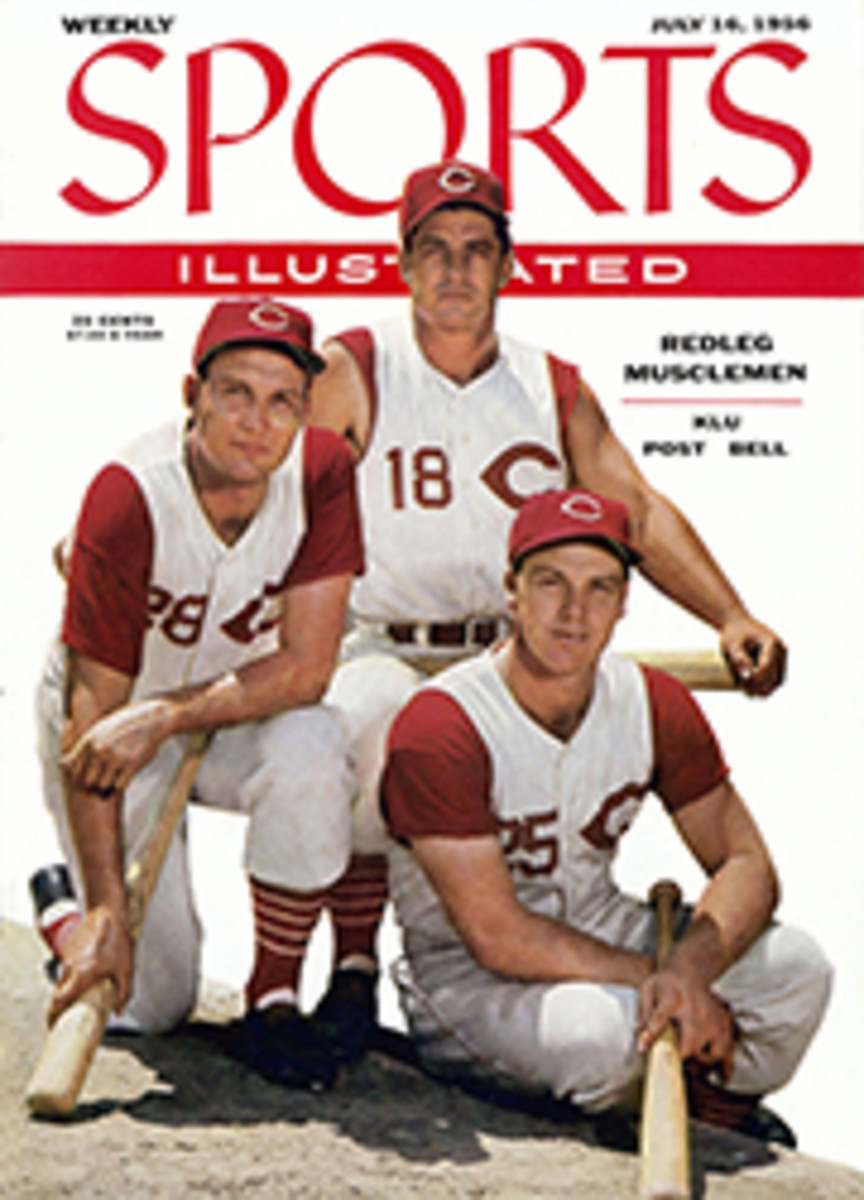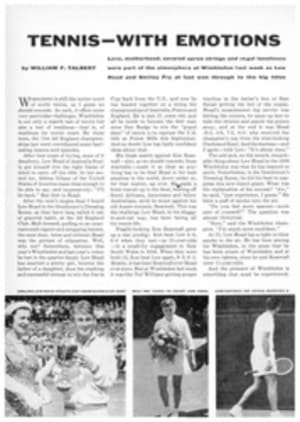
Once again the young man from Australia dominated the famed British Open, which is fast becoming a THOMSON TEA PARTY
HOYLAKE, ENGLAND
On the links of the Royal Liverpool Golf Club at Hoylake, Australia's Peter Thomson won the British Open golf championship for the third successive year. This was a feat which had not been accomplished since Bob Ferguson beat 39 competitors with a score of 171 for the two rounds at St. Andrews, Scotland in 1882. In terms of golf those were prehistoric days. The Royal Liverpool Club was 13 years old—it had been founded in 1869 in the Royal Hotel, into which you can still slice your second shot to the 17th, by Mr. J. Muir Dowie, after whom the short 7th hole is called today—and it was to be 12 more years before the Open was first played in England. Between then and now the only time the three-year record was in danger was in 1907 when the great James Braid, the most modest of men, declared he would have won had he not burst his braces (suspenders to you) at the 8th hole in the final round. This too was at Hoylake. The winner was Arnaud Massy, the only Frenchman to win the British Open, as a result of which he christened his newlyborn daughter "Hoylake," presumably pronounced "Oylak."
Times change, and the British Open is not perhaps what it used to be, either in the days when all the giants of golf were on this side of the Atlantic or during the annual American invasions of the Golden Twenties. But, with nearly a century of history behind it, the Open retains a quality possessed by few other golfing events—one of them is the Masters tournament at Augusta—namely, that the occasion is greater than the man. People who have been good enough to win it, and would have given anything to win it, have in the end been overcome by it. Thomson—young, debonair, not overawed by tradition or history—is not one of these. His record over five years is a very remarkable second, second, first, first, first.
Through the Canada Cup having been played the week before, this was, I suppose, the most international Open championship since golf began, as witness the countries represented by the first 15 players—Australia, Belgium, Mexico, South Africa, Scotland, Argentina, England, United States, Eire, Wales and Spain.
From the United States we had several welcome visitors—and none more welcome than the oldest, Gene Sarazen. Can it really be 24 years ago that we watched the smiling, stumpy figure striding up the last hole to win at Sandwich? To qualify for the final day in the wind and rain at Hoylake at the age of 54 is no mean achievement, and there was general sorrow when he withdrew to fly home for the funeral of his friend Carl Snyder, killed in the Grand Canyon air crash.
BIG BALL, SMALL BALL
Frank Stranahan came again, bringing memories of the last Hoylake Open when he needed 2 to tie and came within inches of holing his second shot. He did well enough with 72-76-72-76 to finish 10 shots behind. Also the veteran Pete Burke, who had been playing a British 50-year-plus; Ernest Kenyon, for the curiously styled world senior championship, an event which, with all respect to the participants, makes as little impact here as doubtless it does in America. Finally, Muscleman Mike Souchak, who made an excellent first impression with 74-74-74-72 in conditions which must have amazed him. In the first qualifying round he was at one point 10 over par but managed to get away with it. As a result, Sarazen thought he would win. "He can reach every hole here in 2," he said, "and he's had his scare." Souchak played fine stuff through the green, but had difficulty with the small ball when he got there. As one who plays habitually with both, and despite anything which even Hogan may say to the contrary, I am satisfied that it is more difficult to change from big ball to small than vice versa. Anyway, all who met Souchak at Hoylake hope to see him again.
Looking back, it was Thomson's championship from the start. He lay well with a 70 on the first day, led only by Dennis Smalldon of Wales (68) and Enrique Bertolino, two-time Argentine champion (69). On the second day, with another 70, he took the lead from Bertolino and Roberto de Vicenzo—Bertolino having bounced back into play off the wrist of a holiday-making Liverpudlian standing out of bounds in the public road at the 17th. "Two inches higher," said the man darkly, "and I'd have had a new watch off him."
Thomson on the second day was lucky. Hoylake lies on the tip of the Wirral Peninsula, separating the estuaries of the Mersey and the Dee, a piece of land which to tens of thousands of Americans was their first sight of England in the wartime lifeline known as the "Western Approaches." It gets the full force of the weather, which for several hours on that day was unspeakably vile, with a 40-mile-an-hour wind blowing torrents of rain in from the sea. Thomson missed a good deal of this, but among those eliminated from final day were Locke (79) and Stan Leonard of Canada (83). Leonard's teammate, Al Balding, had 81, but survived to finish in 300. Both were booked for Commonwealth vs. Britain match on July 21, but decided to go home, feeling themselves, as they unaccountably said, to be "not welcome." Nothing could be farther from the truth, but no one can account for what goes on in another man's mind.
In the end the only real challenge came from Belgian Flory Van Donck—one of three who tied for low individual score in the Canada Cup last year in Washington. His 33 out in round three was the best of the tournament, and he would have broken 70 had he not left the flagstick in the hole at the 18th and then hit it gently in the middle. In the afternoon he did it again at the 8th. I suppose these fellows know best, but to me it seems quite extraordinary. Van Donck lost his last chance by slicing out of bounds at the first hole after lunch. He battled nobly on for a 74, but Thomson coasted calmly round in the same figure to win by three shots.
One other hero deserves a mention. Henry Cotton, who at 49 finished 17th in the U.S. Open, here finished sixth, and his 32 home over one of the toughest finishes in British championship was the best in five days. As a striker of the golf ball he remains almost unmatched, a permanent reminder that style lasts longer than brute force.
Two of the greatest Americans won at Hoylake—Walter Hagen in 1924, when he casually knocked in a 10-footer for victory by one stroke, and later, when questioned, let fall the immortal remark, "No man ever beat me in a playoff"; and Bobby Jones in 1930, the year of his great Grand Slam. If they had been there to see Peter Thomson acclaimed on the 18th green, I know they would have found him worthy to join their company.
ILLUSTRATION
"If you're not going to relax, let me sit there!"
BIOPERSE
Peter William Thomson comes from Brunswick, Australia, which is a suburb of Melbourne, but not one of its more "residentially desirable" ones. He was born there in 1929, and the first loves of this curly-headed youngster were hunting, fishing and cricket. "Like every Australian boy, I hoped someday to play for my country in Test cricket," Thomson says. "A golfing career did not occur to me."
He first played golf at 12, sneaking onto the neighboring nine-hole Royal Park public course after the regulars had finished. Self-taught, he won his first tournament at 15, his first major victory (the Victorian Amateur) at 18. At 20 he abandoned a promising career as a chemist to turn pro, and victories in the New Zealand and Australian Opens followed quickly in 1950 and 1951. Today experts down under credit him with having Australia's "most calculating and incisive golf mind." Thomson joined the American pro circuit in 1952, a move which has netted him close to $40,000 in winnings.
That year the personable young Thomson married Lois Brauer, a pretty Australian brunette, and the two have been circling the globe ever since. The birth of daughter Deirdre two years ago didn't interrupt Thomson's travels, and Deirdre, who has already logged 50,000 miles, can one day say, trouper fashion, that she was raised in a golf bag.
The stockily built, 5-foot 9-inch 165-pounder will play in next month's rich Tarn O'Shanter World Championship at Niles, Illinois, and then head home to Australia, where he will hunt ducks while planning another swing across the world's links.

